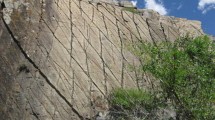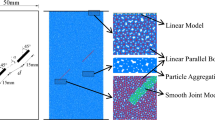Abstract
Rock bridges are commonly encountered in incipiently jointed rock masses and rock engineering practices, which play a significant role in the stabilization of rock masses. Although the effect of joint length, as a key influence factor on mechanical properties of rock bridges, has been extensively studied, the influence of joint dip angle and aperture on fractured rock properties has rarely been investigated. In this study, we carried out an investigation on a new conceptual model of fractured rock bridges, based on the evaluation of a pre-existing transfixion joint in the middle and two rock bridges of equal length on both sides. The specimens with four different joint dip angles and apertures were investigated using uniaxial compression-shear experiments, in which the surface deformation was monitored by the particle image velocimetry (PIV) method. The experimental results demonstrated that the maximum failure load of rock bridges decreased as the joint aperture and dip angle increased, and can be described using a linear and a first-order exponential decay functions, respectively. The rock bridge failure along the projection line of the pre-existing transfixion joint, a dense displacement contours region, was formed along with the formation of new fractures. It was found that the tensile failure effect increases as the aperture increases, and compression failure effect increases with the fracture dip angle decrease. A new method to test rock cohesive c and internal friction angle φ is also provided based on the new conceptual model of artificial rock bridges. The present study helps improve our knowledge of the effect of rock bridges and will contribute to the development of shear strength criteria and test methods.

















Similar content being viewed by others
References
Adrian RJ (1991) Particle imaging techniques for experimental fluid mechanics. Ann Rev Fluid Mech 23:261–304
Asadizadeh M, Moosavi M, Hossaini MF, Masoumi H (2018) Shear strength and cracking process of non-persistent jointed rocks: an extensive experimental investigation. Rock Mech Rock Eng 51(2):415–428
Burke TSDS, Elshafie MZEB (2021) Arching in granular soils: experimental observations of deformation mechanisms. Géotechnique 71(10):866–878
Cai WB, Li Y, Gao K, Wang K (2022) Crack propagation mechanism in rock-like specimens containing intermittent flaws under shear loading. Theor Appl Fract Mec 117:1–16
Diederichs MS (2003) Rock fracture and collapse under low confinement conditions. Rock Mechan Rock Eng 36(5):339–381
Einstein HH (2021) Fractures: tension and shear. Rock Mech Rock Eng 54:3389–3408
Elmo D, Donati D, Stead D (2018) Challenges in the characterisation of intact rock bridges in rock slopes. Eng Geol 245:81–96
Elmo D, Stead D, Yang B, Marcato G, Borgatti L (2022) A new approach to characterise the impact of rock bridges in stability analysis. Rock Mech Rock Eng 55(5): 2551–2569
Gerolymatou E, Triantafyllidis T (2016) Shearing of materials with intermittent joints. Rock Mech Rock Eng 49(7):1–12
Ghazvinian AH, Azinfar MJ, Vaneghi RG (2012) Importance of tensile strength on the shear behavior of discontinuities. Rock Mech Rock Eng 45(3):349–359
Ghazvinian A, Nikudel MR, Sarfarazi V (2007) Effect of rock bridge continuity and area on shear behavior of joints. Int Soc for Rock Mech:247–250
Guo JQ, Liu PF, Huang SX, Qian Y, Liu GJ (2021) Cracking processes and failure modes of rock-like specimens with a set of non-persistent joints. Geotech Geol Eng 39(2):1–21
Haeri H, Sarfarazi V, Marji MF, Hedayat A, Zhu Z (2016) Experimental and numerical study of shear fracture in brittle materials with interference of initial double cracks. Acta Mech Solida Sin. 29(5):555–566
Havaej M, Stead D, Lorig L, Vivas J (2012) Modelling rock bridge failure and brittle fracturing in large open pit rock slopes. In: 46th US Rock Mechanics/Geomechanics Symposium. OnePetro
Kemeny J (2005) Time-dependent drift degradation due to the progressive failure of rock bridges along discontinuities. Int J Rock Mech Min Sci 42(1):35–46
Kim BH, Cai M, Kaiser PK, Yang HS (2007) Estimation of block sizes for rock masses with non-persistent joints. Rock Mech Rock Eng 40: 169–192
Luo XY, Cao P, Lin QB, Li S (2021) Mechanical behaviour of fracture-filled rock-like specimens under compression-shear loads: an experimental and numerical study. Theor Appl Fract Mec 113:1–20
Paronuzzi P, Bolla A, Rigo E (2016) 3D stress–strain analysis of a failed limestone wedge influenced by an intact rock bridge. Rock Mech Rock Eng 49(8):3223–3242
Shang J, Zhao Z, Ma S (2018) On the shear failure of incipient rock discontinuities under CNL and CNS boundary conditions: insights from DEM modelling. Eng Geol 234:153–166
Shemirani AB, Haeri H, Sarfarazi V, Hedayat A (2017) A review paper about experimental investigations on failure behaviour of non-persistent joint. Geomech Eng 13(4):535–570
Snow DT (1970) The frequency and apertures of fractures in rock. Int J Rock Mech Min Sci Geomech Abstr Pergamon 7(1):23–40
Sun PP, Yang XX, Sun DK, Qiao WG, Wu Y (2020) Geometric and mechanical properties of a shear-formed fracture occurring in a rock bridge between discontinuous joints. B Eng Geol Environ 79(3):1365–1380
Tang P, Chen GQ, Huang RQ, Wang D (2021) Effect of the number of coplanar rock bridges on the shear strength and stability of slopes with the same discontinuity persistence. B Eng Geol Environ 80(1):3675–3691
Tang P, Chen GQ, Huang RQ, Zhu J (2020) Brittle failure of rockslides linked to the rock bridge length effect. Landslides 17(4):793–803
Tuckey Z, Stead D (2016) Improvements to field and remote sensing methods for mapping discontinuity persistence and intact rock bridges in rock slopes. Eng Geol 208:136–153
Wang XR, Wang EY, Liu XF, Zhou X (2021) Failure mechanism of fractured rock and its AE behaviors under different loading rates. Eng Fract Mech 247(16):1–15
Wang Y, Yang HN, Han JQ, Zhu C (2022) Effect of rock bridge length on fracture and damage modelling in granite containing hole and fissures under cyclic uniaxial increasing-amplitude decreasing-frequency (CUIADF) loads. Int J Fatig 158:106741
Wawersik WR, Fairhurst C (1970) A study of brittle rock fracture in laboratory compression experiments. Int J Rock Mech Min Sci Geomech Abstr 7(5):561–575
White DJ, Take WA, Bolton MD (2003) Soil deformation measurement using particle image velocimetry (PIV) and photogrammetry. Géotechnique 53(7):619–631
Wong RHC, Chau KT (1998) Crack coalescence in a rock-like material containing two cracks. Int J Rock Mech Min 35(2): 147–164
Wong RHC, Leung WL, Wang SW (2001) Shear strength studies on rock-like models containing arrayed open joints. In: DC Rocks 2001, The 38th US Symposium on Rock Mechanics (USRMS). OnePetro
Yang XX, Li LC, Sun PP, Wang SC, Li FW (2022) Laboratory investigation of the shear failure process and strength characteristics of a rock mass containing discontinuous joints under water pressure influence. B Eng Geol Environ 81(95):1–13
Yang XX, Sun DK, Jing HW (2020) Morphological features of shear-formed fractures developed in a rock bridge. Eng Geol 278:105833
Zare S, Karimi-Nasab S, Jalalifar H (2021) Analysis and determination of the behavioral mechanism of rock bridges using experimental and numerical modeling of non-persistent rock joints. Int J Rock Mech Min Sci 141:104714
Zhang SC, Li YY, Liu H, Ma XW (2021) Experimental investigation of crack propagation behavior and failure characteristics of cement infilled rock. Constr Build Mater 268(3):1–11
Zhao YL, Zhang LY, Wang WJ, Pu CZ, Wan W, Tang JZ (2016) Cracking and Stress–Strain Behavior of Rock-Like Material Containing Two Flaws Under Uniaxial Compression. Rock Mech Rock Eng 49(7):2665–2687
Zheng YH, Xia L, Yu QC (2015) Analysis of removability and stability of rock blocks by considering the rock bridge effect. Can Geotech J 53(3):384–395
Zhou XP, Zhang JZ, Yang SQ, Berto F (2021) Compression-induced crack initiation and growth in flawed rocks: a review. Fatigue Fract Eng M 44(7):1681–1707
Funding
This study received support from the National Natural Science Foundation of China under Grant No. 41602298 and the Henan Institution of higher Education Key Scientific Research project (22A170013). BF was supported by the U.S. Department of Energy under Contract No. DE-AC02-05CH11231.
Author information
Authors and Affiliations
Corresponding author
Ethics declarations
Conflict of interest
The authors declare no competing interests.
Rights and permissions
Springer Nature or its licensor (e.g. a society or other partner) holds exclusive rights to this article under a publishing agreement with the author(s) or other rightsholder(s); author self-archiving of the accepted manuscript version of this article is solely governed by the terms of such publishing agreement and applicable law.
About this article
Cite this article
Wang, WX., Su, LY., Faybishenko, B. et al. Uniaxial compression-shear experiments of artificial rock bridges with a pre-existing transfixion joint based on PIV method. Bull Eng Geol Environ 82, 408 (2023). https://doi.org/10.1007/s10064-023-03396-w
Received:
Accepted:
Published:
DOI: https://doi.org/10.1007/s10064-023-03396-w




